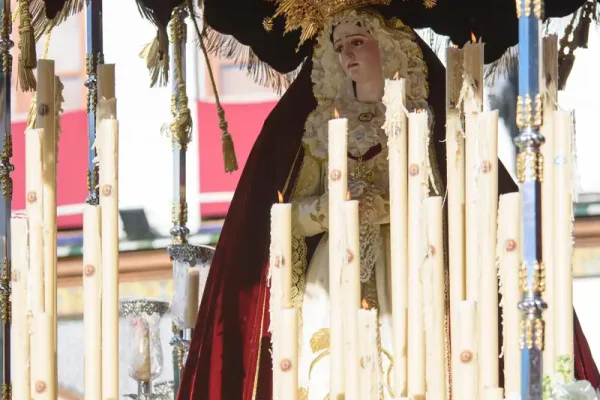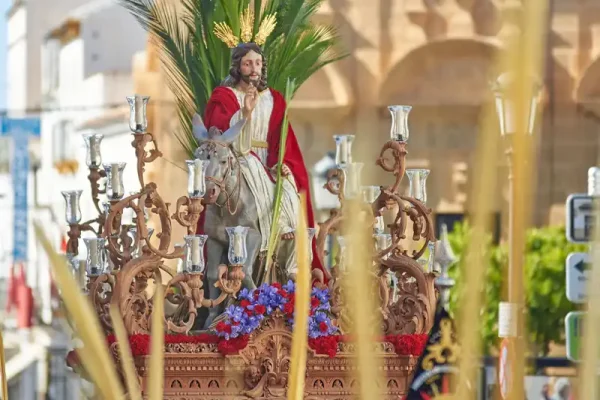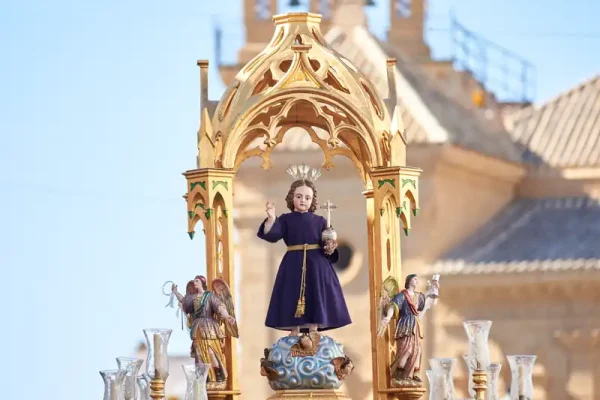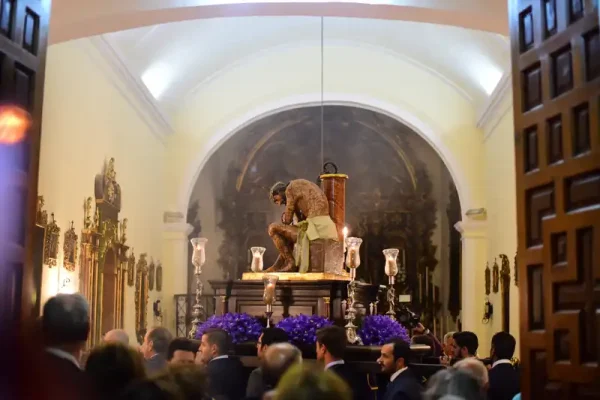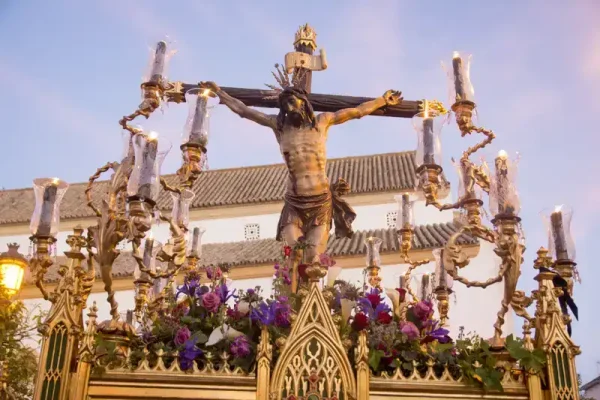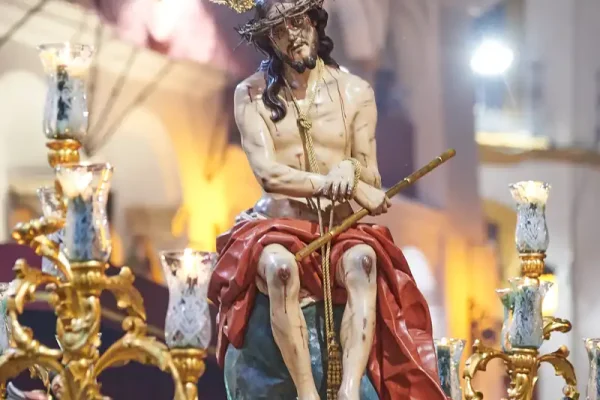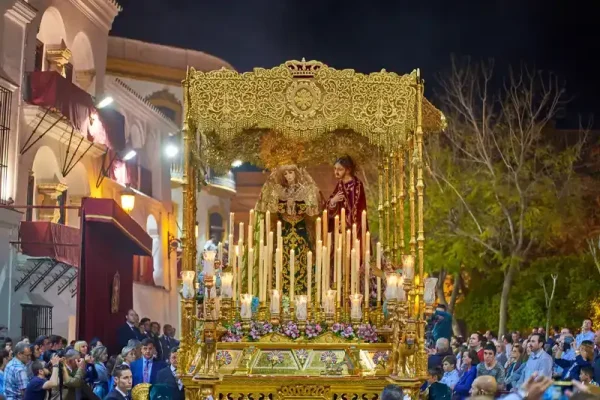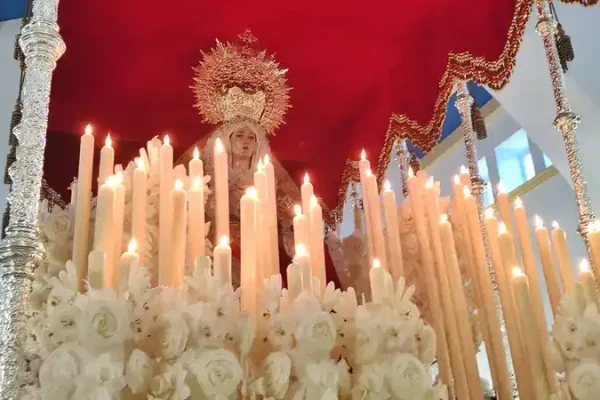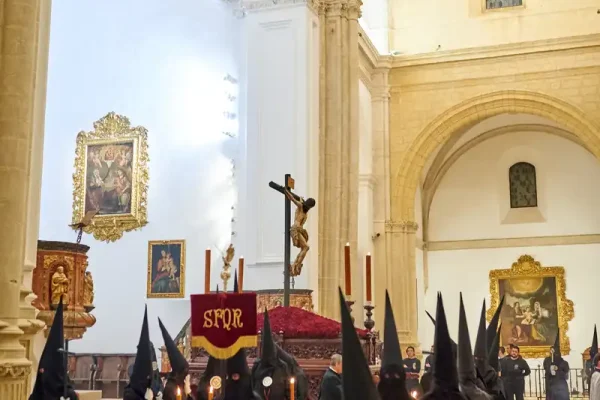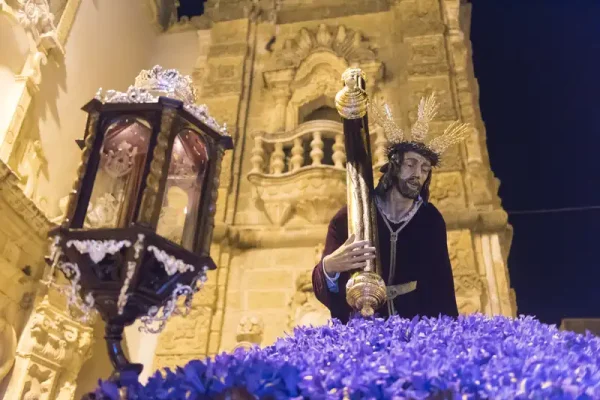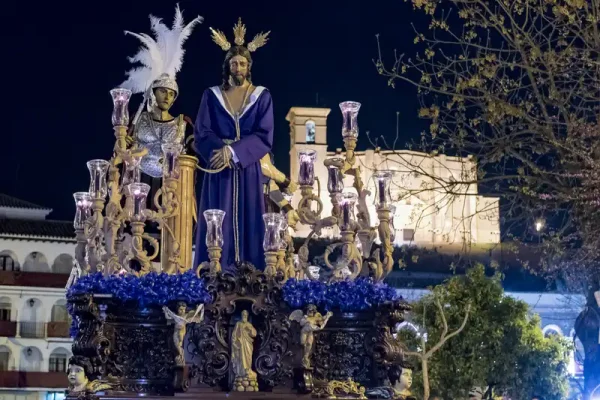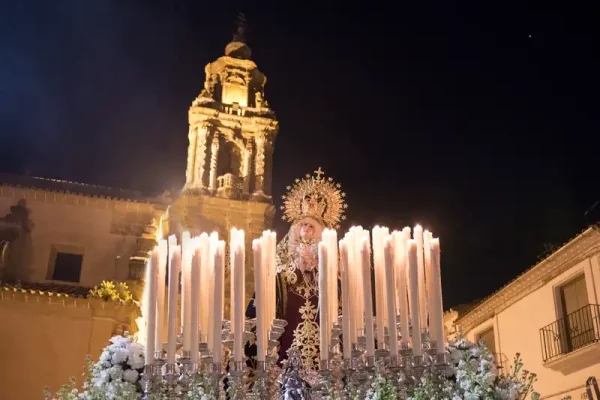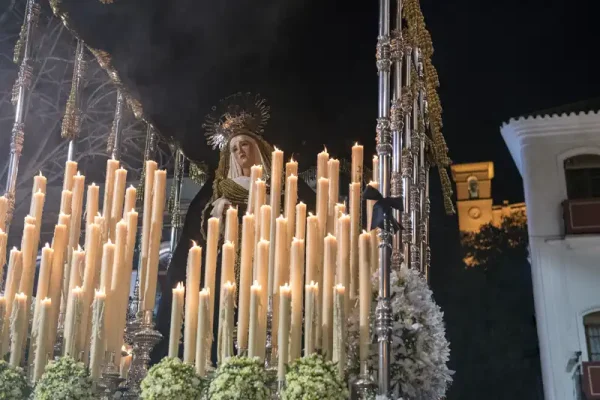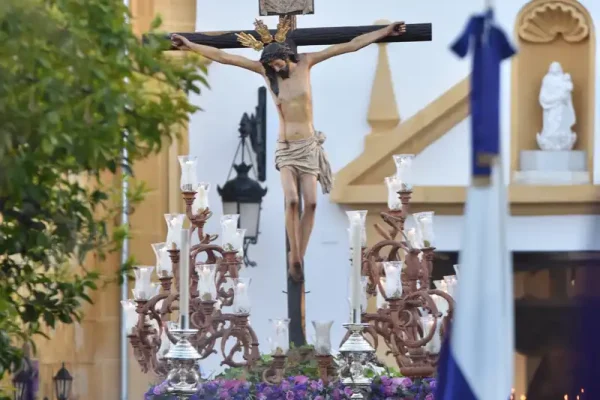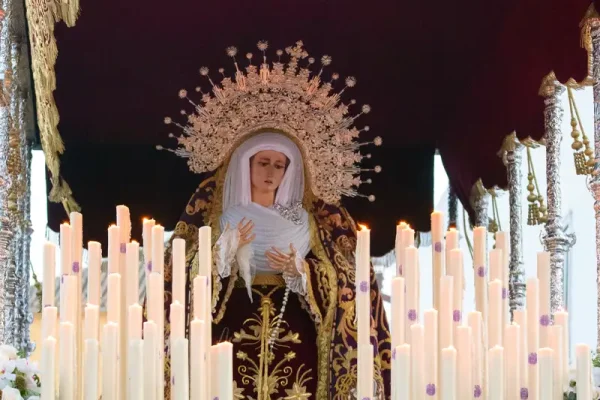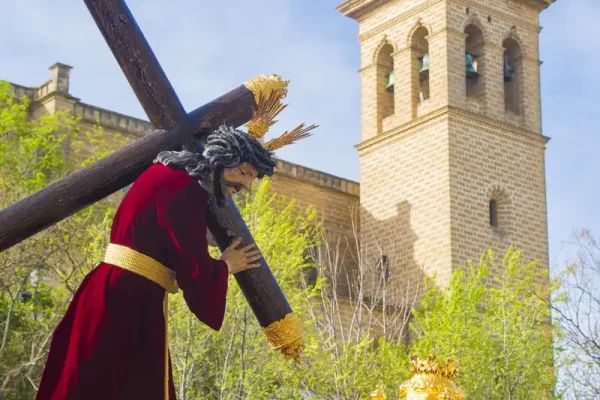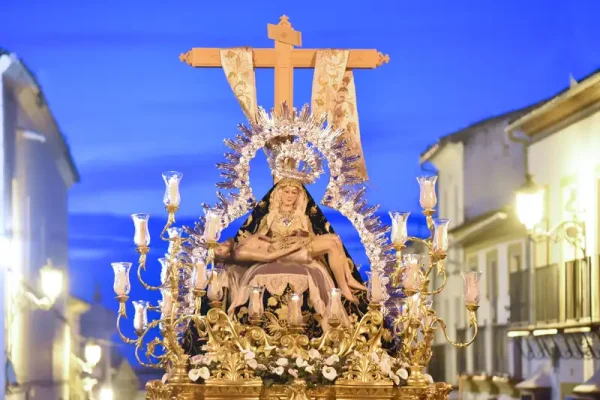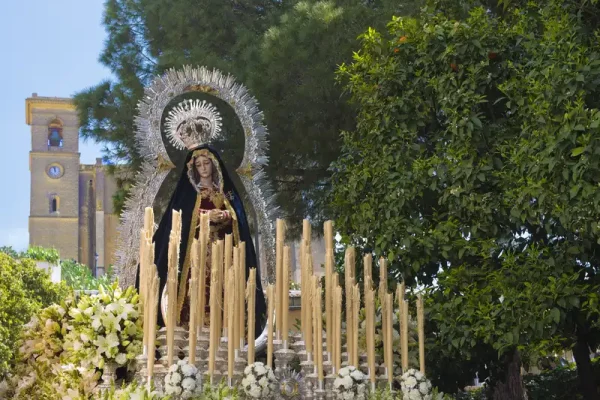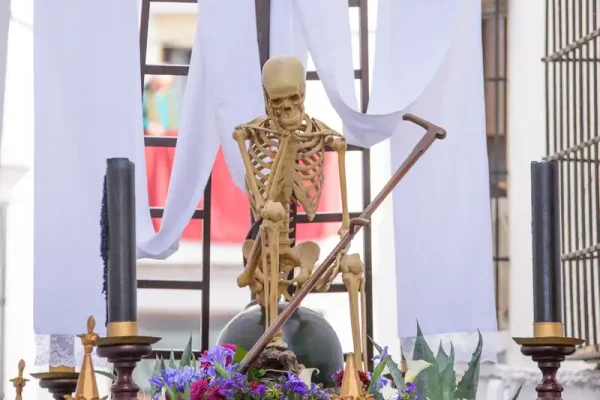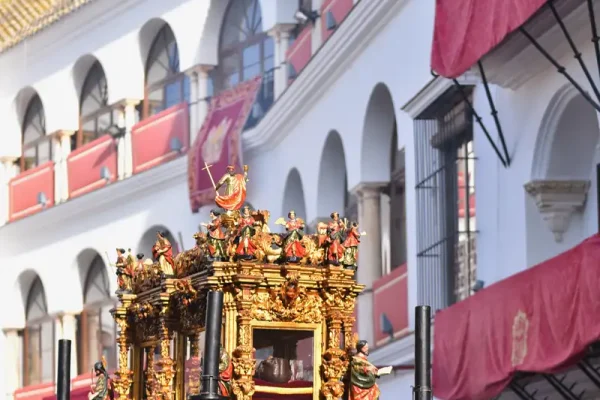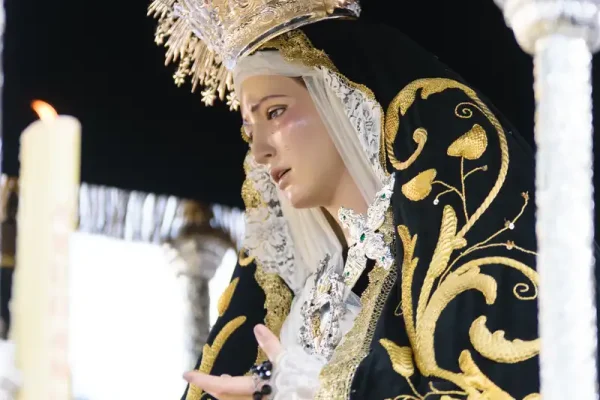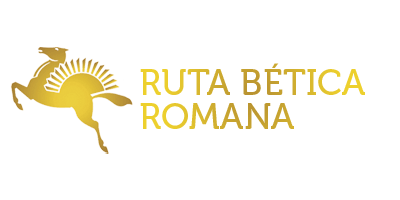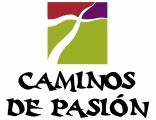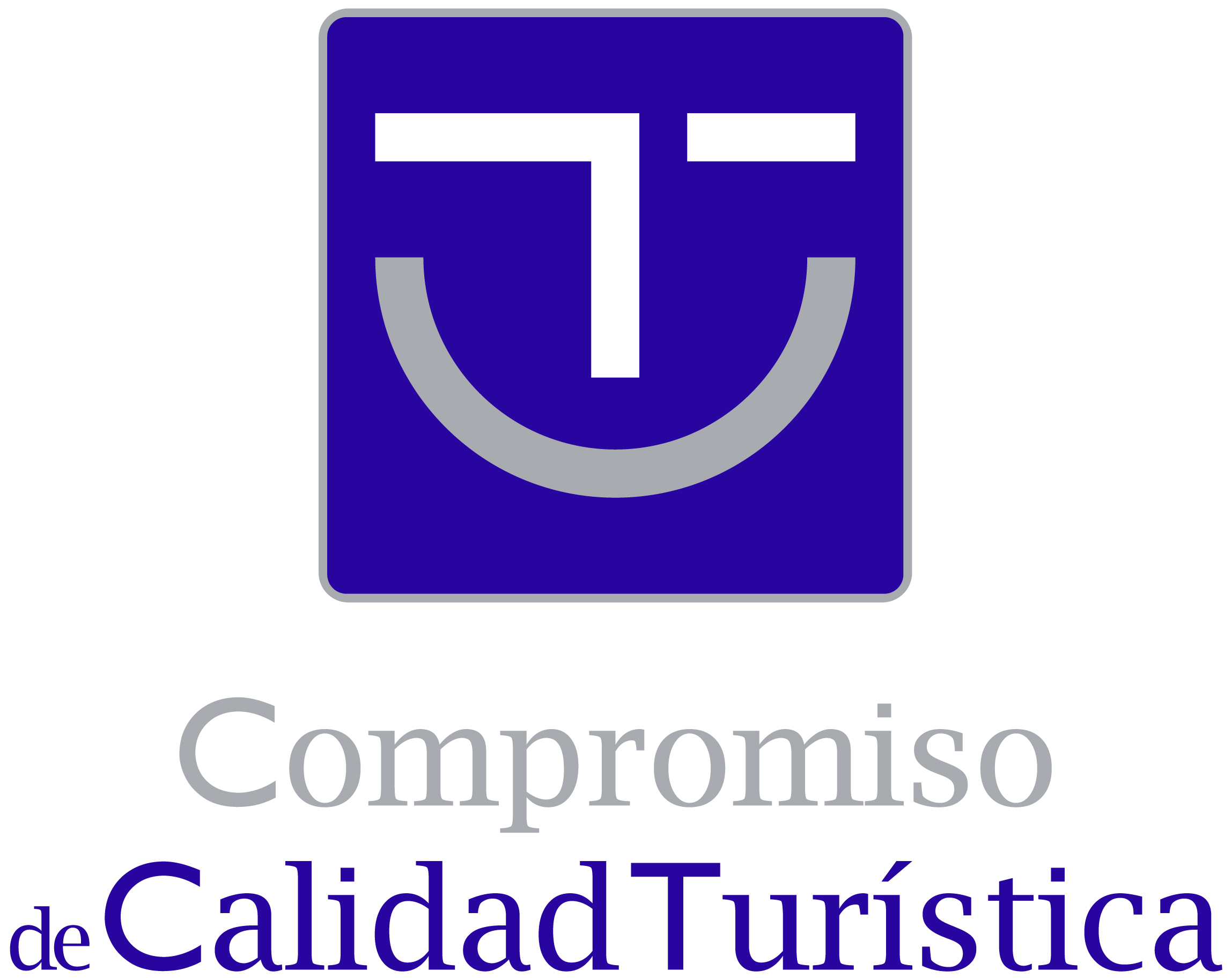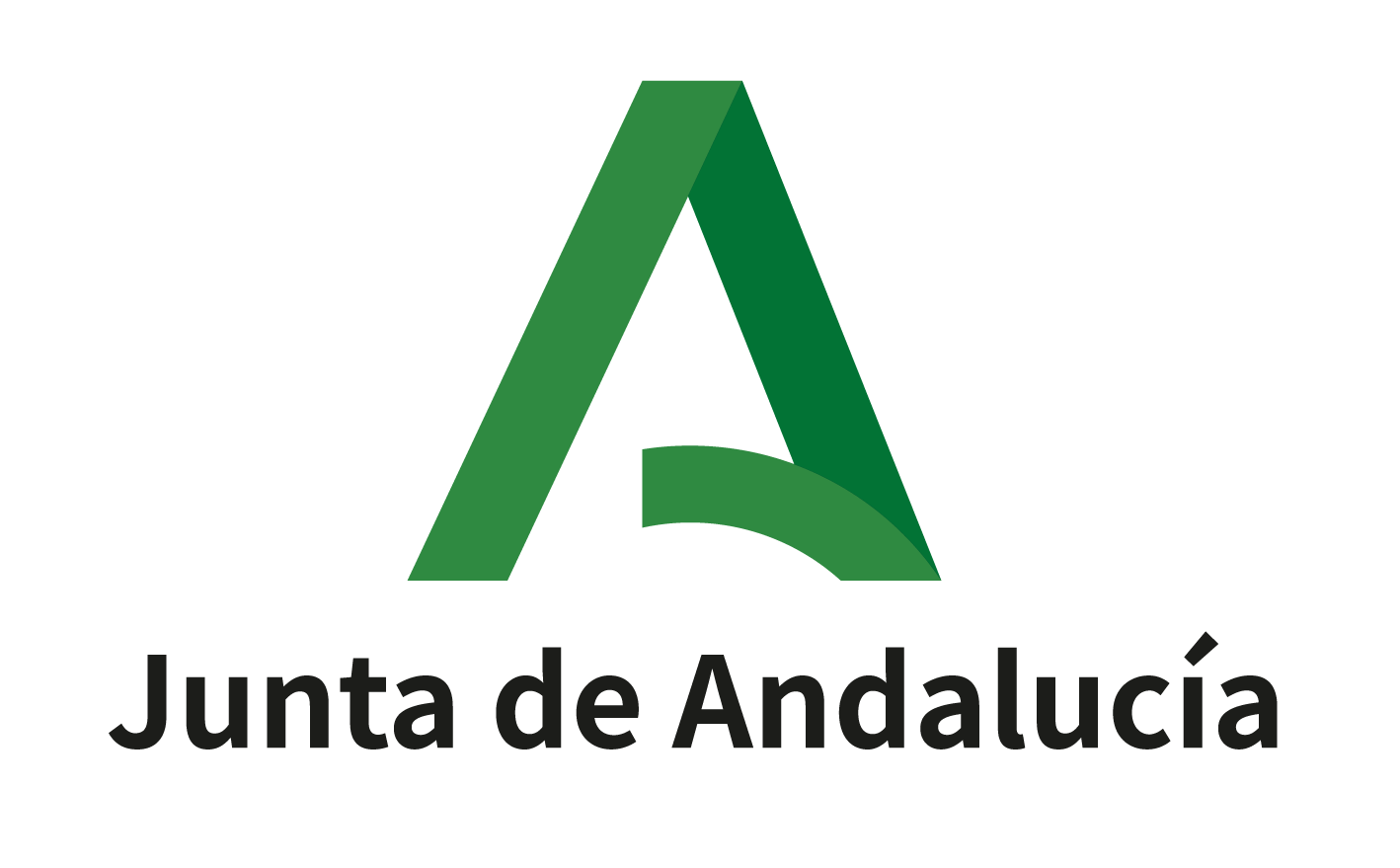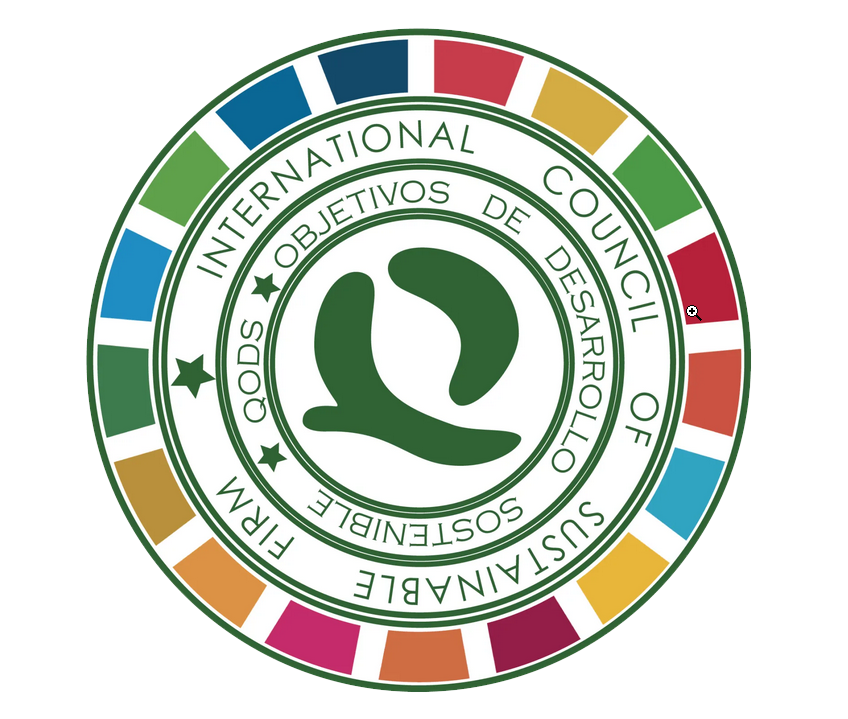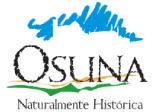


Palm Sunday
BROTHERHOOD OF DULCE NOMBRE DE JESÚS , TRIUNFAL ENTRADA DE JESÚS EN JERUSALÉN Y NUESTRA SEÑORA DE LOS DESAMPARADOSThis brotherhood was founded on 7th March, 1582 led by the Order of Preachers that only worshipped the image of Dulce Nombre. At the end of the 19th century, the brotherhood bought a carving of a Virgin Dolorosa called Nuestra Señora de los Desamparados. Its penitential procession takes place each Palm Sunday. In 1960 a carving of Jesus riding a donkey was ordered with the purpose of representing the triumphal entry of Jesus into Jerusalem.
Nowadays, this brotherhood is comprised of three processions, which leave the church of Santo Domingo such as “Niño perdido” of unknown author and belonging to 15th century, the Triumphal Entry of Jesus into Jerusalem, commonly known as “La Borriquita”. This procession belongs to the second half of the 20th century and was made by the Art´s workshop of Olot. The third one is the “Virgen de los Desamparados” from the 19th century, attributed to Juan de Astorga. Whose traditional olive tree was replaced by a palm tree.
Easter Monday
WAY OF THE CROSS OF OUR FATHER JESUS OF HUMILITY AND PATIENCEAccording to oral tradition, this brotherhood was founded in 1602 by the “Esparteros guild”, popularly known as the brotherhood of “Los Pellejos”, since some of the brothers had a kind of leather boots which contained an unguent to heal the wounds that were made by the penitents. In Osuna there were not processions in Easter Monday until the year 2000, when the brotherhood restored the primitive carving Nuestro Padre Jesús de la Humildad y Paciencia.
This carving represents the image of Christ alone and helpless seated in a natural stone from the Mount Calvary. The iconographic origins of this procession are medieval and date from the 14th century. However the Cristo de la Humildad belongs to the 16th century. During that period, one of the most famous artists of the German Reinassance, Alberto Durero, used this theme on the cover of the collection of xylographs, named “Little Passion”.
Durero represents Christ with his hand resting on his cheek. The brotherhood is comprised of three images: Nuestro Padre Jesús de la Humildad y Paciencia, by an unknown artist belonging to 16th century; Cristo atado a la columna, by Mr. Antonio Izquierdo Benegas from Sevilla between 1964 and 1965; and María Santísima de la Soledad which belongs to 1840, attributed to Mr. Juan de Astorga and made up of cedar wood. The first image that went on procession of this brotherhood was “El Cristo de la Humildad y Paciencia” , until 1965 when they decided not to go on procession anymore due to its deterioration. From that moment, the carving was preserved in the convent of Las Madres Carmelitas of Osuna remaining there until 1998, when the brotherhood decided to restore it.
In grateful recognition to Las Madres Carmelitas, the brotherhood transferred its primitive carving to the convent of San Pedro, where it is worshipped one week before Easter and from there, it goes on procession (Via Crucis) each Easter Monday. This Via Crucis passes through some streets of the neighbourhood. As the carving of the Cristo de la Humildad was deteriorated it was ordered to create a carving of the Cristo atado a la columna as a substitute. The starting point of the procession is the Covento Padres Carmelitas church.
Easter Tuesday
ANTIGUA Y HUMILDE HERMANDAD DEL SANTO CRISTO DE LA VERA-CRUZ, JESÚS CAUTIVO Y NUESTRA SEÑORA DE LA ESPERANZAThe Brotherhood of La Santa Vera Cruz was founded in 1545 in the Franciscan convent of Madre de Dios, where it had its own chapel, added to San Juan de Letrán Archibasilica from Rome. After the Franciscan temple collapsed in December 1944, the brotherhood moved to the ancient convent of San Agustín, where it rests since then.
El Cristo de la Vera Cruz is an anonymous work executed between the third and fourth decade of the 16th century. It is made up of wood. It goes on procession in a gothic style pace belonging to the end of the 19th century carried out in the workshop of Hipólito Rossi. . The sculpure of Santo Ecce Homo del Portal, currently known as Nuestro Padre Jesús Cautivo, made in 1765 by the sculptor Fernando Ortiz from Málaga, in order to lead the main altarpiece of the convent of San Francisco. The image of the carving of Nuestra Señora de la Esperanza, which replaced the ancient image of Nuestra Señora de la Soledad, was made as well as the image of San Juan Evangelista by the sculptor Vicente Tena in 1901, from Valencia. Both images go on procession in an Oriental style pace from the end of 19th century from which the figures of griffins and effigies in the corners stand out, known as “La Virgen de los Perritos”.
This brotherhood goes on procession from San Agustín Church with great expectation of people.
We need to highlight the many “saetas” (type of traditional singing) that accompany the procession during its route and its passage through the main square “Plaza Mayor”.
Easter Wednesday
BROTHERHOOD OF NTRA. SRA. DEL ROSARIO AND FÁTIMA BROTHERHOOD OF OUR FATHER JESÚS DE LA SALUD AND MARÍA SANTÍSIMA DE LA ENCARNACIÓNThe procession of our father Jesús of Healthy, the work of Darío Fernández, will in the future be a mystery composed of the Lord, Pontius Pilate, Claudia Procula, two Roman soldiers, a servant with a basin and Barabbas. Its first procession was in 2024. Previously, María Santísima of la Encarnación was carried in procession on Passion Sunday.
The image of the Virgin received the blessing the 10th of January, 2013 in the Monasterio de la Encarnación. The carving is the work of Javier Rojas Pouzols.
Agrupación Parroquial de María Santísima de la Encarnación y el Rosario de Fátima
It is important to highlight some features of this image, such as the burgundy velvet dress embroidered with gold, the blue velvet cloak with lace, as well as the sash with Swarovski crystals and pearls.
This Virgin goes on procession every Passion Sunday from Ntra. Sñra. Del Rosario de Fátima church. We can emphasize its way to the Reyes Católicos square, where it will be received by its neighbourhood.
Maundy Thursday
BROTHERHOOD OF SANTÍSIMO CRISTO DE LA MISERICODIA, NUESTRA SEÑORA DE LA PIEDAD Y SAN JUAN EVANGELISTAAccording to the history of the Brotherhood, one Holy Tuesday, as a result of a severe drought in 1723, the Christ of la Misericordia went on procession carried on the shoulders of the “capellanes” and before sunset, the procession was back to the Colegiata (Collegiate Church). The present name of the Brotherhood was adopted in 1928 and its rules were approved in 1929 being the Eldest Brother Mr. José Castro Maldonado. Formerly, the Penitential procession was made each Good Friday at 15:00 p.m., some years later this Brotherhood went on procession on Maundy Thursday evening and currently, it goes on procession every Holy Wednesday at midnight.
The carving of this Christ was ordered by the canon of the Collegiate Church, Mr. Diego de Ontiveros to the sculptor Juan de Mesa in 1623. It is made of cedar wood and it has an academic size.
This Brotherhood is also known as the “Silence Brotherhood” because the silence reigns during all the Penitential procession solemnly. Furthermore, by this reason, the “venia” (permission to go on procession) is requested in silence.
ROYAL BROTHERHOOD OF PENITENCE AND HUMBLE MERCEDARIAN SLAVERY AND BROTHERHOOD OF NAZARENES OF THE DENIALS AND TEARS OF SAINT PETER AND OUR LADY AND MOTHER OF SORROWS
It was founded in La Merced Church by Mr. Manuel de Ávalos y Pimentel in 1705. In its beginnings, it was an eminently monastic brotherhood in which the Mercedarians “descalzos” had an important role to its foundation and its development. After the collapse of La Merced Church in 1964, Mercedarians moved to Santo Domingo Church until today, from where they go on procession.
The Brotherhood is comprised of two images such as Nuestro Padre Jesús Caído, a polychrome cedar wood carving; its author is a sculptor from Écija called Alonso Gayón, belonging to 1703. And Nuestra Señora y Madre de los Dolores, an anonymous image from 18th century that traditionally was attributed to the sculptor Juan de Astorga from Málaga, but according to recent researches by José Luis Romero situated the dating even more ancient, attributing the image to the sculptor Salvador Guitérrez de León.
REAL HERMANDAD Y COFRADÍAS DE NAZARENOS DE NUESTRO PADRE JESÚS DE LA HUMILDAD Y PACIENCIA, CRISTO ATADO A LA COLUMNA Y MARÍA SANTÍSIMA DE LA SOLEDAD.
According to oral tradition, this brotherhood was founded in 1602 by the “Esparteros guild”, popularly known as brotherhood of the “pellejo”, since some of the brothers had a kind of leather boots which contained an unguent to heal the wounds that were made by the penitents.
The brotherhood is comprised of three images: Nuestro Padre Jesús de la Humildad y Paciencia, by an unknown artist belonging to 16th century; Cristo atado a la columna, by Mr. Antonio Izquierdo Benegas from Seville between 1964 and 1965; and María Santísima de la Soledad belongs to 1840 which is attributed to Mr. Juan de Astorga and made up of cedar wood.
The first image that went on procession of this brotherhood was “El Cristo de la Humildad y Paciencia” until 1965 that they decided not to go on procession more due to its deterioration. From that moment, the carving was preserved in the convent of Las Madres Carmelitas of Osuna remaining there until 1998, when the brotherhood decided its restoration. In grateful recognition to Las Madres Carmelitas, the brotherhood transferred its primitive carving to the convent of San Pedro, where it is worshipped one week before Easter and from there, it goes on procession (Via Crucis) each Easter Monday. This Via Crucis (the Way of Crosses) passes through some streets of the neighbourhood. As the carving of the Cristo de la Humildad was deteriorated they ordered to create a carving of the Cristo atado a la columna as a substitute.
The starting point is the Covento Padres Carmelitas church.
Good Friday
FERVENT BROTHERHOOD OF OUR FATHER JESUS OF NAZARETHThis brotherhood was founded in the last quarter of the 16thcentury, on 8th July 1576 and its headquarters are located in the former school of Ntra. Señora de la Victoria de la orden del Señor San Francisco de Paula. Its first rules date back a year later.
Currently, it is the brotherhood that has more faith among people, approximately 1283 “nazarenos” (some of them with candles and others with crosses) accompany the procession. The image that goes on procession is a baroque size of a “Nazareno”; although anonymous, it is attributed to the Pedro Roldán School “El Mozo”. The face of the “Nazareno” reflects the acceptance of his destiny, the redemptive death of Christ on the cross.
We need to highlight the steep hill slope of San Antón and Encarnación square.
SACRAMENTAL BROTHERHOOD AND VENERABLE THIRD ORDER OF SERVANTS OF OUR MOTHER AND LADY OF SORROWS
The patent of this Brothehood Venerable Orden Tercera de los Siervos de María de Osuna was issued in 1719 from the Valencian convent of Holy Sepulchre of Quart. However, the Colegio de los Mínimos de la Victoria de la Esclavitud Servita de Nuestra y Señora de los Dolores was founded in 1730. The following year, the community of Mínimos granted the use of the chapel. The carving of the virgin is attributed to José de Mora from the end of the 17th century or beginning of the 18th century. The entire size of the virgin has a mantle and the ‘saya’ embroidered with geometrical and vegetal motifs; her clasped hands are holding a heart pierced by seven daggers.
It goes on procession from the Victoria church on the early Good Friday, walking up the steep slope of San Antón and Encarnación square.
ANCIENT, VENERABLE AND FERVENT BROTHERHOOD AND CONFRATERNITY OF NAZARENO OF OUR LADY AND MOTHER OF THE FIFTH ANGUISH
In order to study the origin of this former Brotherhood, we are very fortunate to preserve the original book of foundational Rule; it is a unique case in our town. It was founded in the convent of the Holy Spirit on 30th October 1580. Some time later, on 3rd December, the headquartes of the brotherhood weere moved to the San Francisco convent passing through different churches (Santo Domingo and Santa Clara Church) due to the collapses. Currently, its headquarters are located in the Victoria church. The carving of the virgin was made by an unknown artist and dates back to the Brotherhood foundation; the image of the Christ was replaced by the present one belonging to the Illanes workshops in 1934. These two images make up an interesting iconographic version.
As a peculiarity, the float of this brotherhood has more than 400 flowers called ‘calas’ picked up by the neighborhood. Furthermore, the carving of the Piedad goes on the streets of the town in semidarkness.
BROTHERHOOD OF SANTO CRISTO DE LA PAZ Y MARÍA SANTÍSIMA DEL MAYOR DOLOR
This Brotherhood was founded on April the 4th 1653 and it is located in Ntra. Sra. De Consolación Church. Since its foundation until 1836, it was ruled by the Friars of the Order III de Penitencia de Nuestro Seráfico Padre San Francisco de Asís. The first book of the Rule of this Brotherhood dates back to 1940 and it was made by Fray Carlos María Martín Gil, from the convent of Carmen of Osuna.
The Christ of Peace is a gothic carving which dates back to 16th century by an unknown artist. The image represents a dead Christ with his head turned to one side. It is a cruficied Christ hanging on the cross by three nails. The virgin of Mayor Dolor is a complete sculpture with a beautiful face also by an unknown artist which has a pearl polychrome.
Easter Saturday
BROTHERHOOD OF THE GLORY BURIAL OF NUESTRO SEÑOR JESUCRISTO EN EL MISTERIO DE SU MUERTE Y RESURECCIÓN, MARÍA SANTÍSIMA EN SU SOLEDAD Y AMARGURA, TRIUNFO DE LA SANTA CRUZ Y NTRA. SRA. DE LA CABEZAThis Brotherhood was founded by the Marquis of La Gomera as a familiar brotherhood and its primitive title was Brotherhood of Nuestra Señora de la Cabeza. Since its foundation, there have been very few penitential processions being its last one in 1696. It has been located in the convent’s church of the Dominicans in a baroque chapel with the same name of this Brotherhood, closed until its restoration. Its revitalization starts at the beginning of 1993, and its first penitential procession was in 2000. Currently, this Brotherhood is located in the church of San Carlos el Real, making its procession from Santa Clara church.
This Brotherhood is comprised of three floats: the image of The Lying Christ that is anonymous and before 1715, the wood carved and golden case was made by José Cueto and Juan Pineda between 1824 and 1828; the image of the Virgin was made by the sculptor Marcos Antonio Humanes in 2008 and the third image is the Triumph of the Holy Cross, popularly known as “La Canina”.
As a peculiarity, we can appreciate a replica of the tower of San Carlos el Real and Santo Domingo Church on the Easter float of the Virgin, highlighting the image of Ntra. Sra. De la Asunción.

